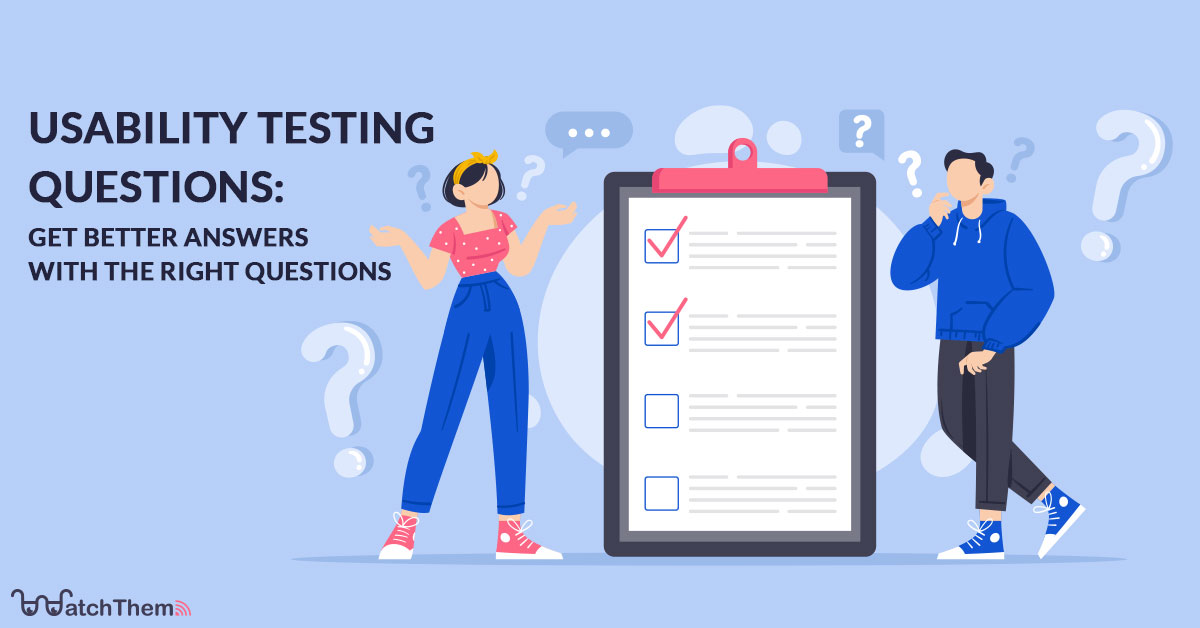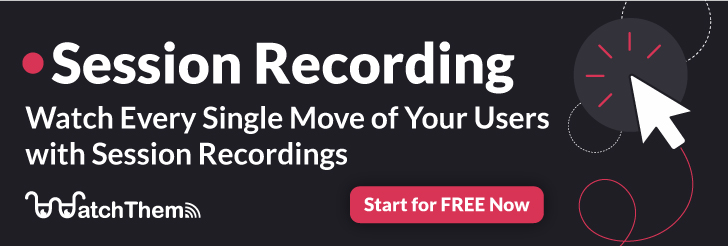Page Contents
You need usability testing to build a smooth customer experience. Also, conducting usability testing is essential for designing a product that users want and need and finding the pain points of your existing product.
An important part of usability testing is asking users questions, and this is no easy task. Developing the right questions will lead to gaining useful insight into your business. So you should know what you need to ask instead of asking random questions. This article will help you get better answers to the right questions.
Note: After developing the right questions, you need a tool to help you conduct the usability test. For this means, you need a tool to record users’ interactions with your website. WatchThemLive will do that for you.
What Are the Usability Testing Goals?
Usability testing is the process of evaluating users’ interaction with your product in order to give them the best experience. There are several ways and tools for conducting usability testing, but first, you need to think about the questions you want to ask. Usability testing and the questions you ask help you determine several things:
1. Understanding Your Product’s Unique Value Proposition
You’re working in a rather highly competitive market. For that reason, you need to find out what makes your solution a better choice. One of the usability testing goals is to determine your product’s unique value proposition. Basically, it discovers how well your solution solves customer problems.
2. Find Out About the Most Important Elements Of Your Product
Usability testing helps you discover the most valuable features of your website or product. This helps you find what is driving the most value and how much effort you need to put into making it better.
One of the best ways to understand the most important features of your website is using a heatmap tool. Heatmaps are a way to visualize data and will show you the most clicked area of your website. WatchThemLive allows you to create heatmaps for any page of choice.
Sign up here and snag their heatmaps now!
3. Identify Pain Points
One of the usability testing goals is to identify points of friction that cause unpleasantness in the user’s journey. This works for testing your existing products, and you can do this by using sample groups.
What Are the Types of Usability Test Questions and Examples?


There are three types of usability questions: screening or pre-testing, in-testing, and post-testing. If you want actionable results for designing a new product or changing your current product, you need the right questions. Below, we will discuss each of these types and give you some examples for each.
1. Screening or Pre-Testing Usability Questions
Finding the right test participants is a bit tricky. You can’t just test anyone who wants to participate in your usability testing. Your participants should reflect your target audience to drive the most relevant data.
The best thing to do is to acquire them from your existing or potential users. Screening questions should help you determine the personal factors that might influence the user experience. Here are some useful screening questions:
- What is your gender?
- How old are you?
- What’s your level of education?
- What is your job?
- What kind of devices do you usually use?
- How often do you use technology?
- How easy is it for you to use these devices?
- What’s your income level?
- On average, how much time do you spend online?
- What kind of websites do you usually use?
- How often do you shop online?
- Did you have any experience with this product before?
- How often do you do something? (description relating to the task in mind)
- Have you used any product (in your line of business) before?
- What kind of product are you currently using to solve your problem? (which your product could also solve)
2. In-Testing Usability Questions
These types of questions help you uncover any problems users face while interacting with your website or product. In this stage, you ask participants to complete tasks and ask them questions as they work with your website. Basically, you gather information about why users do what they do.
Here are some examples of this type of usability testing questions:
- What is stopping you from completing the task?
- What features do you value the most, and why?
- What features do you value the least, and why?
- How long did it take you to complete the task?
- When you first entered the website, what was the first thing you did?
- What do you think about the design?
- How was your experience from completing the task?
- How was the user interface?
- How was the navigation to page X?
- What do you think about the language used?
- What motivated you to click on the X feature?
An excellent way to record visitors’ interactions with your website or web app is using session replay software. For example, you can see how they navigate your website or how much time it takes them to complete tasks. Also, you can see what stops them from completing a task or cause them frustration and other useful information. Watch this video for more information:
Interested? Sign up here and see what’s next!
3. Post-Testing Usability Questions
Once the test is over, it’s a good time to ask follow-up questions or the questions you forgot to ask. In this stage, you should ask questions about participants’ overall experiences. You can also ask if they have any questions. This will help you get more valuable information about your product.
Let’s take a look at some examples:
- How was your overall experience with this product?
- If there was one thing you could change with our website or product, what would it be?
- On a scale from 0-10, how likely is it that you recommend us to your friends?
- If you could add one thing to the product, what would it be?
- What did you like the most about the product?
- What did you like the least about the product?
Some Points About Asking Usability Testing Questions
Here are a few things to consider about usability testing questions:
- Usability testing questions should be open-ended. Avoid the questions that can be answered only with yes or no. Ask participants to elaborate on their answers to gain actionable insight.
- Don’t put words in participants’ mouths. For example, don’t ask if the navigation was good; ask how the navigation was. In such cases, participants might just answer yes to avoid saying more.
- If participants have questions, don’t give them answers; guide them only. For example, if they “ask what should I do next?” answer with “what do you think you should do next?”
- Use the think-aloud protocol. This means asking participants to think out loud while completing tasks.
- Make sure to make participants comfortable and avoid judging them. You want their honest opinion, and if you don’t create a comfortable experience, they will only say the things you want to hear.
Conclusion
Usability testing questions are an important part of usability tests. With the right questions, you will get the right answers. You should learn how to ask questions to get the best result. If you don’t know how your questions should be, you end up asking useless questions that won’t give you any insight.
If you are looking for a way to get more accurate answers to your usability questions, it’s a great idea to use session replay software, such as WatchThemLive. By watching session replays, you can exactly see how users perform tasks on your website or product.
Sign up here and start your usability testing now!



